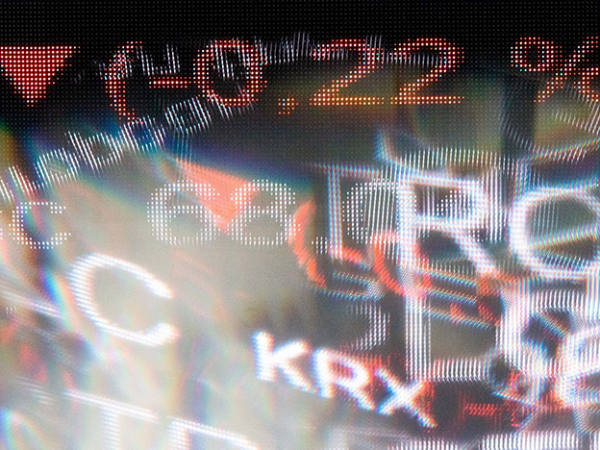Low volatility exchange traded funds (ETFs) have grown popular with investors in recent years due to their low price tags and promise to cushion portfolios against the most dramatic market drops. But one size does not fit all when it comes to so-called 'smart-beta' ETFs, so which method should you opt for and what are the pitfalls?
What are low volatility ETFs and how do they work?
In response to our feature on shock-absorbing funds, several readers came forward in favour of low-volatility ETFs, which track subsets of major indices focused on less volatile components. "Approaching 80 and worrying about a volatile market, I am considering more ETFs, particularly those that provide a blend and minimum volatility," said one. While another reader in his 80s is considering iShares MSCI World Minimum Volatility ETF (MINV) in order to "go low risk/volatility".
Low volatility vs minimum variance
There are two schools of thought behind the construction of low volatility ETFs and the method used wll determine what risks you are exposed to.
Low volatility indices are compiled using the least volatile stocks from a parent index based on historical standard deviation data. These indices are skewed towards defensive sectors of the economy like healthcare and utilities, based on a view that defensive sectors fall less dramatically than others in a bear market. However, these funds will still fall in a bear market and will also suffer when markets in general are rising, with the most concentrated portfolios experiencing the worst time.
Adam Laird, passive investment manager at Hargreaves Lansdown, says: "Historically studies have shown that low volatility stocks produce slightly better risk adjusted returns that one might expect given that they experience low risk.
"But if you look at the records back to 2008 all stocks fell and everything because very correlated. A lot of these products are very new so it is difficult to see how these strategies have performed in different market conditions."
Alternatively, minimum variance indices balance equities according to historical volatility but also take a portfolio-wide view. This method relies on analysing the correlations between stocks at portfolio level to establish what selection generates the least overall risk. Funds based on this method are more diversified but will also trade underlying stocks more frequently and could bring in lower returns over the long term due to costs associated with portfolio rebalancing.
Christopher Aldous, managing director of Charles Stanley Pan Asset, says: "We use minimum volatility ETFs when we're concerned about equity risk and we would use minimum variance strategies just where we want to diversify portfolio risk and reduce overall portfolio volatility."
The options: Global equities
The iShares MSCI World Minimum Volatility UCITS ETF (MINV) tracks the return of the MSCI World Minimum Volatility Index, which takes into account the absolute volatility of stocks in the parent index as well as the correlation between all constituents in the parent index. It has a 0.3 per cent ongoing charge.
Despite being a minimum variance strategy it is 43 per cent concentrated in defensive stocks according to Morningstar data, with 17 per cent of the portfolio exposed to healthcare.
The fund has not tracked its benchmark that closely since inception compared with its peer, Lyxor UCITs ETF MSCI World Risk Weighted (WDRL). WDRL has tracked the MSCI World Risk weighted index better but is a more complex vehicle based on swap contracts. The index is constructed by reweighting the constituents of its market cap weighted parent index and is rebalanced in May and November each year.
One qualm with these strategies is that they focus on volatility measures instead of value measures. One way of trying to capture the overlap between low volatility and value premiums, the idea that value stocks offer greater risk-adjusted returns than growth stocks, is by paying attention to the equity valuations of ETFs.
WDRL has a price to book valuation of 1.81 according to Morningstar, one of the most appealing, along with Ossiam World Minimum Variance UCITS ETF 1C (LWMV) at 1.88. LWMV has an appealing total valuation with price/ prospective earnings at 15.82 and price/cash flow figure at 6.65, implying its underlying stocks may be good value.
European equities
The SPDR Euro Stoxx Low Volatility UCITS ETF (ELOW) aims to track the least volatile Eurozone securities. It has closely tracked its index since launch.
Although it has just 100 stocks, ELOW is more diversified in sector terms than iShares MSCI Europe Minimum Volatility UCITS ETF (IMV). However, IMV is the cheaper product of the two, with a 0.25 per cent ongoing charge.
When considering a low volatility ETF it is worth considering portfolio concentration, turnover, cost and overall strategy in order to decide what kind of product will work best for you. These are shown in the table below.
Low volatility ETFs comparison
| ETF | Code | Strategy | Ongoing charge | Concentration | Portfolio turnover |
| GLOBAL | |||||
| iShares MSCI World Min Vol | MINV | Min variance | 0.3 | High | semi-annual |
| Lyxor ETF SG Global Quality Income | SGQP | Min variance | 0.45 | Low | na |
| iShares MSCI World Quality Factor | IWQU | Min variance | 0.3 | Low | semi-annual |
| Ossiam World Min Variance | LWMV | Min variance | 0.65 | Low | semi-annual |
| Lyxor UCITS ETF MSCI World Risk Weighted | WDRL | Min variance | 0.45 | Low | na |
| EUROPE | |||||
| iShares MSCI Europe Min Vol | IMV | Low vol | 0.25 | High | semi-annual |
| Lyxor SG European Quality Income | SGQE | Min variance | 0.45 | na | na |
| SPDR Euro Stoxx Low Vol | ELOW | Low vol | 0.3 | Low | na |
| UK | |||||
| Ossiam FTSE 100 Min Variance | UKMV | Min variance | 0.45 | High | semi-annual |
| US | |||||
| SPDR S&P 500 low vol | USLV | low vol | 0.35 | High | na |
| iShares S&P 500 min vol | SPMV | Min variance | 0.2 | Low |
Source: Investors Chronicle
Do they do the job?
The big question when it comes to low volatility ETFs is whether or not they end up being less volatile than their original, non volatility adjusted counterparts. As these products are so new, the time period for analysis is limited but there are comparisons to be made and some ETFs clearly fare better than others when the two indices are compared.
When looking at volatility and risk, the key metrics are volatility, a measure of the amount of variation in a fund's performance defined by a calculation called standard deviation, maximum drawdown and downside risk (see table). These allow you to quantify the worst losses you would experience if you bought and sold the fund at the worst time as well as seeing which give you the best cushion against a crashing market.
By comparing the iShares range of low volatility ETFs against their non low volatility counterparts it becomes clear that taking out a low volatility ETF does not always guarantee you a smoother ride.
It is also worth bearing in mind that the performance of these ETFs is for a GBP share class and not the original dollar or euro version of the fund. Re-basing the fund's results into GBP will have an impact on performance and several iShares ETFs perform better in other currencies not applicable to the UK private investor.
The best performer by far out of the three iShares products mentioned is the iShares MSCI Europe Minimum Volatility UCITS ETF, which beat the iShares MSCI Europe UCITS ETF on every metric examined, making it a truly low volatility option.
The fund fared better than its non volatility version in standard deviation figures for 2013, 2014 and on a cumulative basis. If you had bought and sold the fund at the worst possible times, you would also have lost less than if you had bought the iShares Europe ETF.
It also lost less than its rival fund, with 2014 its best year, posting a maximum loss of 2.90 per cent compared to 4.50 per cent for the iShares MSCI Europe ETF.
However, the picture is more mixed for the two other iShares products discussed. The iShares MSCI World Minimum Volatility ETF does outperform its comparable World ETF when it comes to annual downside risk. On a two year cumulative basis the product delivered a lower downside risk, at 6.75 per cent compared to 7.48 per cent for its comparable World ETF.
But the minimum volatility ETF had a bad year in 2013 when it came to beating its non volatility adjusted ETF. In 2013 it posted a worse maximum drawdown figure of 5.94 compared to 4.12 for the MSCI World ETF and in 2013 posted a higher volatility figure of 13.58 per cent compared to 11.75 per cent for the iShares World product. That meant that the iShares minimum volatility product underperformed in cumulative performance terms.
The S&P 500 product would have protected the least against volatility when compared to its non volatility adjusted S&P peer. Although the fund was less volatile on a cumulative two-year basis it lost more according to maximum drawdown figures in 2013 and had a higher downside risk in both 2013 and 2014.
However, that does not mean it will not end up being a better bet in the long run in comparison to a non low volatility ETF. The short time span for reference makes it hard to determine whether or not they are likely to succeed in the long run and it could be better to pay attention to the aims of the fund and its investment method rather than historical performance.
Adam Laird, passive investment manager at Hargreaves Lansdown, says: "I try not to put too much store by performance because I don’t think two years is a meaningful record to go on.
"Part of the reason that we and others would consider these is on the back of research being done which would say that they are a good way to invest and we try our best to look into the method that they go through to ask if it is consistent with that. But we don’t wholeheartedly endorse these because we don’t think we’ve seen the full range of market factors and how that hits performance."
Glossary
Volatility: Calculated by using standard deviation, which shows how widely a range of returns varies from the fund's average return over a particular period. Low volatility reduces the risk of buying into an investment which is likely to deliver widely divergent and unpredictable returns.
Maximum drawdown: A percentage demonstrating the amount a fund would have lost if you bought at its peak and sold at the worst time. Can be expressed as a negative figure or positive percentage.
Downside risk: This metric looks at the risk of losses as opposed to the variation in both positive and negative returns from the average. IT is an estimation of a funds potential to suffer a decline in value if the market conditions change, or the amount of loss that could be sustained as a result of the decline.
Performance of low volatility ETFs
| Annual performance (%) total returns | ||||
| Fund | 2015 | 2014 | 2013 | 2012 |
| Global | ||||
| iShares MSCI World Min Vol | 4.5 | 18.2 | 16.4 | |
| Index: MSCI world minimum volatility index | 3.6 | 15.8 | 22.1 | |
| Lyxor ETF SG Global Quality Income* | 4.3 | 11.7 | 2.6 | |
| Index: SG Global Quality Income NTR | 7.8 | 17.9 | 5.9 | |
| iShares MSCI World Quality Factor | 4.3 | n/a | n/a | |
| Index: MSCI World Sector Neutral Quality | 5.0 | n/a | n/a | |
| Ossiam World Minimum Variance UCITS ETF | -0.1 | 12.0 | 21.0 | na |
| Index: Ossiam World Minimum Variance Index | -0.0 | 12.6 | 21.7 | na |
| Lyxor UCITS ETF MSCI World Risk Weighted | -0.5 | 5.6 | 22.7 | 12.6 |
| Index: MSCI World Risk Weighted | -0.5 | 6.1 | 23.2 | 12.9 |
| Europe | ||||
| iShares MSCI Europe Min Vol | 4.6 | 7.3 | 19.4 | na |
| Lyxor SG European Quality Income | 9.2 | 6.8 | 5.3 | na |
| Index: SG Euro Qual Inc Idx PR | 9.3 | 8.3 | 5.4 | na |
| SPDR Euro Stoxx Low Vol | 9.1 | 11 | na | na |
| Index: Euro Stoxx low risk weighted 100 index | 9.2 | 10.7 | na | na |
| UK | ||||
| Ossiam FTSE 100 Min Variance | 5.5 | 5.6 | 19.9 | 14.4 |
| Index: Ossiam FTSE 100 Minimum Variance | 5.5 | 6.3 | 20.6 | 15.1 |
| US | ||||
| SPDR S&P 500 low vol | -0.5 | 16.4 | 22.5 | -1.8 |
| Index: S&P 500 low volatility index | -0.4 | 16.5 | 22.4 | -1.9 |
| iShares S&P 500 min vol** | 17.3 | 14.6 | 27.3 | na |
| Index: S&P 500 minimum volatility index | 17.1 | 27.1 | na | na |
Source: FE Analytics
Comparable volatility metrics of iShares minimum volatility vs counterpart ETFs
| 2-yr cumulative annual volatility to 2014 year end | Discrete annual volatility 2013 | Discrete annual volatility 2014 | Discrete annual mx drawdown 2013 | Discrete annual max drawdown 2014 | 2-yr cumulative downside risk to 2014 | 1-yr cumulative downside risk to 2014 | |
| iShares MSCI Europe Minimum Volatility UCITS ETF TR in GB | 10.35 | 11.56 | 9.20 | -3.64 | -2.90 | 7.91 | 6.91 |
| iShares MSCI Europe UCITS ETF Acc EUR in GB | 12.25 | 13.62 | 10.38 | -4.88 | -5.23 | 9.87 | 9.13 |
| iShares MSCI World Minimum Volatility UCITS ETF USD in GB | 10.68 | 13.58 | 7.35 | -5.94 | -1.99 | 6.75 | 3.35 |
| iShares MSCI World UCITS ETF Inc USD TR in GB | 9.84 | 11.75 | 7.64 | -4.12 | -3.00 | 7.48 | 5.35 |
| iShares S&P 500 Minimum Volatility UCITS ETF USD in GB | 10.67 | 13.30 | 7.81 | -6.87 | -2.66 | 8.17 | 6.02 |
| iShares S&P 500 UCITS ETF Inc USD TR in GB | 10.92 | 13.21 | 8.49 | -6.36 | -2.76 | 7.68 | 4.97 |
Source: FE Analytics










